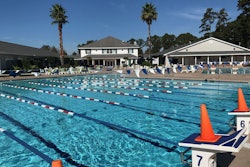SOURCE: Tennis Industry Association (TIA)
ORLANDO, Fla. — Virtual Tennis, a virtual reality athletic concept that marries VR technology with intense broad-spectrum physical competition, took the top prize in the fourth edition of the Tennis Industry Innovation Challenge—a “Shark Tank”-like competition to identify the most innovative and creative product or service in the tennis industry.
Presented by the Tennis Industry Association (TIA), the Innovation Challenge took place during the recent Racquet & Paddle Sports Conference at the Orange County Convention Center in Orlando, Fla. Three companies, which had been selected from more than 30 overall applicants for this fourth Innovation Challenge, each gave a five-minute presentation on what makes their tennis product or service special, unique and important to the growth of the sport.
In the final analysis, the panel of judges picked the VR athletic game concept Virtual Tennis [www.virtualtennisinternational.com], which is designed to engage kids and others who may not otherwise try or stay with conventional tennis by providing an alternative path to tennis participation. Victor Bond, the CEO of the Virtual Sports Association [www.virtualsportsassociation.com], based in Walnut Creek, Calif., presented to the panel of six judges and to a tennis industry audience.
“What’s the biggest inhibitor to the growth of tennis now and for the foreseeable future?” Bond asked during his presentation. “It’s screens. The average kid in the U.S. between ages 6 and 18 spends seven non-school hours in front of screens every day. This is a major issue!”
“Can you beat the screens?” he continued. “No, you can’t. So you join them, more healthily.”
Bond says playing Virtual Tennis is “like the Nintendo Wii, but 10 times more athletic. We’re bringing to this whole virtual sport arena a characteristic that doesn’t exist yet—the opportunity for real, serious, officially sanctioned competition with other people. We want virtual reality to be an enabler to something else that’s important to people, and that is the chance to compete at the highest levels, from their living rooms.”
Bond is positioning Virtual Tennis as a virtual sport and working to get it “sanctioned” as an official sport, a true discipline of tennis.
“Tennis is the only major sport that also is one of the most ‘virtualizable’ sports, and because of that, we can have kids and adults competing globally, from their living rooms, for major prizes and recognition—up to and including the Olympic Games in Paris in 2024. We have the chance to not only change the future of tennis, we have the chance to lead the future of sports.”
While the “fundamental behaviors” of playing conventional tennis are transferable to Virtual Tennis, such as the serve and ground-stroke motions, Bond says Virtual Tennis wasn’t developed to be a simulation of conventional tennis, and is in fact dramatically different from playing conventional tennis. Players are physically active in Virtual Tennis, navigating within a space that is about 6 feet in diameter to hit a ball back and forth, judging angles off the walls, floor and ceiling. Players also can put spin on the ball in Virtual Tennis.
Key to the concept, though, is having virtual sports “tied to an existing and compelling competition infrastructure. We will enable people to participate in high-level, high-quality virtual reality tennis for real recognition and rewards,” Bond says.
“Victor’s enthusiastic, forward-looking presentation excited the audience and the judges,” said Carlos Salum, president of Salum International Resources and a member of the SportsCouncil Silicon Valley, who was the moderator for the Innovation Challenge. “Our judges had a lot of questions for him, and I think by the end of the presentation, everyone was ready to put on a VR headset and try out Virtual Tennis!”
As the winner of the Tennis Industry Innovation Challenge, the Virtual Sports Association received a $1,000 cash prize, in addition to a national news release to about 2,000 media outlets with a potential audience of 30 million consumers; coverage in Tennis Industry Magazine; a membership in the TIA; and other benefits.
The other two finalists in the competition were AccuTennis (www.accutennis.com), which uses a computer vision system to provide live feedback for recreational and competitive players, and the PlayTennisConnect app (www.foundationtennis.com), which is a complete business management system for providers and provides an integrated experience for players.
“The Innovation Challenge is designed to provide a showcase to the most creative products that can increase awareness, engagement and participation in tennis, as well as improving playing performance,” said TIA Executive Director Jolyn de Boer. “Like our previous editions of the Challenge, our applicants for Orlando embodied this spirit of innovation, and the three finalists all had strong presentations that connected with the tennis industry audience. The TIA is pleased to offer this unique platform to entrepreneurs, with an eye toward increasing tennis participation and enjoyment for all consumers.”
Judges for the Tennis Industry Innovation Challenge in Orlando were:
* Stacey Allaster, USTA chief executive of professional tennis and former chairman and CEO of the WTA.
* Mike Barrell, coach for more than 30 years and the director of evolve9, an international company that helps national tennis federations and providers design and implement tennis programs for children.
* Walid Fattah, a tennis entrepreneur based in Los Angeles, with extensive experience in the world of finance. Fattah co-founded a family of products under the name Kourts.
* Louis Foreman, the founder and chief executive of Enventys Partners, an integrated product design, engineering and marketing firm.
* Dr. Mark Kovacs, a performance physiologist, researcher, professor, author and coach who currently runs a consulting firm focusing on optimizing human performance.
* Mac Lackey, a Charlotte, N.C.-based entrepreneur who has built and sold five companies. He is a co-founder and serves as chairman of ISL Futbol.
The first Tennis Industry Innovation Challenge was held in March 2017 at the Tennis Owners & Managers (TOM) Conference in Orlando, Fla., and was won by Tennibot (tennibot.com), a robotic tennis ball collector. The second Challenge, held in August 2017 in New York City during the 2017 US Open, was won by In/Out (inout.tennis), a line-calling device that fits on any netpost. The third Challenge, held during the TOM Conference in April 2018 in Charleston, S.C., was won by Tweener Lighting (tweener-lighting.com), a unique LED system that attaches to existing fencing around tennis and other sport courts.
The inaugural Racquet & Paddle Sports Conference (racquetpaddlesportsshow.com) was held Jan. 23-25 in Orlando, co-located with the PGA Merchandise Show. The multi-faceted tennis, racquet and paddle sports industry event—organized by the TIA (tennisindustry.org) and Reed Exhibitions—featured a hands-on product demo experience and opening welcome party at the USTA National Campus in Lake Nona; a curated ONE2ONE buying event; the 2019 TOM Conference; and an exhibit pavilion of racquet, paddle and tennis vendors and organizations at the Orange County Convention Center.
About the TIA
The Tennis Industry Association, the not-for-profit trade association for tennis, is THE unifying force in the tennis industry whose mission is to promote the growth and economic vitality of the business of tennis by working closely with its industry partners and in support of the USTA in their development of initiatives to increase tennis participation. Core TIA activities include producing more than 70 U.S. and global research reports annually on participation and consumer/trade research, managing the largest relational database, along with hosting annual TIA Tennis Forum, Leadership meetings and the TOM Conference at major tournaments and events. Visit TennisIndustry.org or call 866-686-3036.
Read Next





























